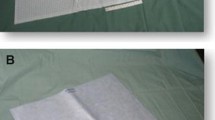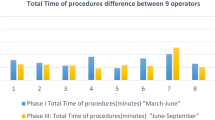Abstract
Cardiac catheterization through radial access is associated with significant ionizing radiation exposure for the operator. We aimed at evaluating whether a removable shield placed upon the patient could impact favorably on annual radiation exposure for the operator. We designed a pre–post study comparing radiation exposure in a total of five operators under standard protection procedures (first period) and after applying a removable shield (second period). Each period included all the procedures performed in 1 year. Radiation exposure was measured through three dosimeters on each operator. A total of 1610 procedures were performed during the first period, and 1670 during the second period. For each operator, Fluoroscopy Time (FT) per exam did not differ between the two periods (13.1 ± 1 vs 12.9 ± 2 min/exam, p = 0.73), whereas Dose-Area Product (DAP) per procedure was slightly higher in the second period (5.247 ± 651 vs 6.374 ± 967 mGy/cm2, p < 0.01). The use of a removable shield significantly reduced operators’ radiation dose at the left bracelet (64.3 ± 13.3 μSv/exam vs 23.8 ± 6.0 μSv/exam, p = 0.003). This remained significant even after adjustment for DAP per procedure (p = 0.015) and number of operators participating to each procedure (p = 0.013), whereas no significant difference was observed for card (5.6 ± 10.5 μSv/exam vs 0.9 ± 0.3 μSv/exam, p = 0.36) and neck bands (3.3 ± 4.5 μSv/exam vs 2.0 ± 2.0 μSv/exam, p = 0.36) dosimeters. The use of a removable shield during cardiac catheterization reduces radiation exposure at the level of the operator's upper limb, whereas no difference was found for other body parts. This may help in reducing radiation exposure of operator’s hand. DAP increase merits further investigation.





Similar content being viewed by others
References
Jolly SS, Amlani S, Hamon M, Yusuf S, Mehta SR. Radial versus femoral access for coronary angiography or intervention and the impact on major bleeding and ischemic events: A systematic review and meta-analysis of randomized trials. Am Heart J. 2009;157:132–40.
Hamon M, Pristipino C, Di Mario C, Nolan J, Ludwig J, Tubaro M, Sabate M, Mauri-Ferre J, Huber K, Niemela K, Haude M, Wijns W, Dudek D, Fajadet J, Kiemeneij F; European Association of Percutaneous Cardiovascular Interventions; Working Group on Acute Cardiac Care of the European Society of Cardiology; Working Group on Thrombosis on the European Society of Cardiology. Consensus document on the radial approach in percutaneous cardiovascular interventions: Position paper by the European association of percutaneous cardiovascular interventions and working groups on acute cardiac care and thrombosis of the european society of cardiology. EuroIntervention 2013;8:1242–51.
Sandborg M, Fransson SG, Pettersson H. Evaluation of patient absorbed doses during coronary angiography and intervention by femoral and radial artery access. Eur Radiol. 2004;14:653–8.
Zorzetto M, Bernardi G, Morocutti G, Fontanelli A. Radiation exposure to patients and operators during diagnostic catheterization and coronary angioplasty. Catheter Cardiovasc Diagn. 1997;40:348–51.
Andreassi MG, Cioppa A, Botto N, Joksic G, Manfredi S, Federici C, Ostojic M, Rubino P, Picano E. Somatic DNA damage in interventional cardiologists: a case–control study. FASEB J. 2005;19:998–9.
Zakeri F, Hirobe T, Akbari NK. Biological effects of low-dose ionizing radiation exposure on interventional cardiologists. Occup Med (Lond). 2010;60:464–9.
l-Sayed T, Patel AS, Cho JS, Kelly JA, Ludwinski FE, Saha P, Lyons OT, Smith A, Modarai B; Guy’s and St Thomas’ Research Consortium. Radiation-induced DNA damage in operators performing endovascular aortic repair. Circulation. 2017;136:2406–16.
Borghini A, Vecoli C, Mercuri A, Carpeggiani C, Piccaluga E, Guagliumi G, Picano E, Andreassi MG. Low-dose exposure to ionizing radiation deregulates the brain-specific miR-134 in interventional cardiologists. Circulation. 2017;136:2516–8.
Murphy JC, Darragh K, Walsh SJ, Hanratty CG. Efficacy of the RADPAD protective drape during real world complex percutaneous coronary intervention procedures. Am J Cardiol. 2011;108:1408–10.
Osherov AB, Seidelin P, Wolff R, Wright GA, Strauss BH, Robert N. A novel lead attenuator to reduce operator exposure to scattered radiation in transradial coronary procedures. EuroIntervention. 2013;9(6):757–60.
Musallam A, Volis I, Dadaev S, Abergel E, Soni A, Yalonetsky S, Kerner A, Roguin A. A randomized study comparing the use of a pelvic lead shield during trans-radial interventions: threefold decrease in radiation to the operator but double exposure to the patient. Catheter Cardiovasc Interv. 2015;85(7):1164–70.
ten Cate T, van Wely M, Gehlmann H, Mauti M, Camaro C, Reifart N, Suryapranata H, de Boer MJ. Novel X-ray image noise reduction technology reduces patient radiation dose while maintaining image quality in coronary angiography. Neth Heart J. 2015;23:525–30.
Dominici M, Diletti R, Milici C, Bock C, Garg S, De Paolis M, Ambrosio G, Boschetti E. Left radial versus right radial approach for coronary artery catheterization: a prospective comparison. J Interv Cardiol. 2012;25(2):203–9.
Dominici M, Diletti R, Milici C, Bock C, Placanica A, D'Alessandro G, Arrivi A, Italiani M, Buono E, Boschetti E. Operator exposure to X-ray in left and right radial access during percutaneous coronary procedures: OPERA randomised study. Heart. 2013;99(7):480–4.
Miller DL, Vañó E, Bartal G, Balter S, Dixon R, Padovani R, Schueler B, Cardella JF, de Baère T. Cardiovascular and Interventional Radiology Society of Europe; Society of Interventional Radiology Occupational radiation protection in interventional radiology: a joint guideline of the Cardiovascular and Interventional Radiology Society of Europe and the Society of Interventional Radiology. J Vasc Interv Radiol. 2010;21(5):607–15.
Radiation exposure to cardiologists. how it could be reduced. Vano E Heart. 2003;89(10):1123–4.
Klein LW, Miller DL, Balter S, Laskey W, Haines D, Norbash A, Mauro MA, Goldstein JA; Joint Inter-Society Task Force on Occupational Hazards in the Interventional Laboratory. Occupational health hazards in the interventional laboratory: time for a safer environment. J Vasc Interv Radiol. 2009;20(7 Suppl):S278–83
Radiation exposure as an occupational hazard. Picano E, Vano E. EuroIntervention. 2012;8(6):649–53.
Hirshfeld JW, Ferrari VA, Bengel FM, et al. 2018 ACC/HRS/NASCI/SCAI/SCCT Expert consensus document on optimal use of ionizing radiation in cardiovascular imaging -Best Practices for Safety and Effectiveness, Part 1: Radiation Physics and Radiation Biology: A Report of the American College of Cardiology Task Force on Expert Consensus Decision Pathways. J Am Coll Cardiol. 2018;71:2811–28.
Roguin A, Goldstein J, Bar O, Goldstein JA. Brain and neck tumors among physicians performing interventional procedures. Am J Cardiol. 2013;111:1368–72.
Venneri L, Rossi F, Botto N, Andreassi MG, Salcone N, Emad A, Lazzeri M, Gori C, Vano E, Picano E. Cancer risk from professional exposure in staff working in cardiac catheterization laboratory: insights from the National Research Council's biological effects of ionizing radiation VII report. Am Heart J. 2009;157(1):118–24.
MATTOS, Eduardo Ilha de et al. Radiation exposure in coronary procedures using the radial and femoral approaches. Rev Bras Cardiol Invasiva São Paulo 2013;21(1):54–59.
Jolly SS, Amlani S, Hamon M, et al. Radial versus femoral access for coronary angiography or intervention and the impact on major bleeding and ischemic events: a systematic review and meta-analysis of randomized trials. Am Heart J. 2009;157:132–40.
Agostoni P, Biondi-Zoccai GG, De Benedictis ML, et al. Radial versus femoral approach for percutaneous coronary diagnostic and interventional procedures: systematic overview and meta-analysis of randomized trials. J Am Coll Cardiol. 2004;44:349–56.
Mamas MA, Anderson SG, Carr M, et al. Baseline bleeding risk and arterial access site practice in relation to procedural outcomes following percutaneous coronary intervention. J Am Coll Cardiol. 2014;64:1554–64.
Gilligan P, Lynch JA, Maguire S. Assessment of clinical occupational dose reduction effect of a new interventional cardiology shield for radial access combined with a custom scatter reducing drape. Phys Med. 2014;30:718.
Behan M, Haworth P, Colley P, Brittain M, Hince A, Clarke M, Ghuran A, Saha M, Hildick-Smith D. Decreasing operators’ radiation exposure during coronary procedures: the transradial radiation protection board. Catheter Cardiovasc Interv. 2010;76:79–84.
Ertel A, Nadelson J, Shroff AR, Sweis R, Ferrera D, Vidovich MI. Radiation dose reduction during radial cardiac catheterization: evaluation of a dedicated radial angiography absorption shielding drape. ISRN Cardiol. 2012;2012:769167.
Kawashima O, Endoh N, Terashima M, Ito Y, Abe S, Ootomo T, Ogata K, Honda H, Takizawa K, Miyazaki Y, Sugawara D, Komatsu M, Sawazi Y, Ozaki T, Uchimuro T, Meguro T, Isoyama S. Effectiveness of right or left radial approach for coronary angiography. Catheter Cardiovasc Interv. 2004;61(3):333–7.
Faroux L, Blanpain T, Nazeyrollas P, Tassan-Mangina S, Heroguelle V, Tourneux C, Baudin F, Metz D. Reduction in exposure of interventional cardiologists to ionising radiation over a 10-year period. Int J Cardiol. 2018;15(259):57–9.
Kobayashi T, Hirshfeld JW. Radiation exposure in cardiac catheterization: operator behavior matters. Circ Cardiovasc Interv. 2017;10(8):1. https://doi.org/10.1161/CIRCINTERVENTIONS.117.005689.
Khaleghi Fard A, Alian AHM, Pourafkari L, Ghojazadeh M, Tarighatnia A, Farajollahi A. Impact of pelvic and rad-board lead shields on operator and patient radiation dose in trans-radial coronary procedures. Radiat Prot Dosimetry. 2019.
Author information
Authors and Affiliations
Corresponding author
Ethics declarations
Conflict of interest
The authors report no financial relationships or conflicts of interest regarding the content herein.
Ethical approval
All procedures performed in studies involving human participants were in accordance with the ethical standards of the institutional and/or national research committee and with the 1964 Helsinki Declaration and its later amendments or comparable ethical standards.
Informed consent
Informed consent was obtained from all individual participants included in the study.
Additional information
Publisher's Note
Springer Nature remains neutral with regard to jurisdictional claims in published maps and institutional affiliations.
Rights and permissions
About this article
Cite this article
Arrivi, A., Pucci, G., Vaudo, G. et al. Operators’ radiation exposure reduction during cardiac catheterization using a removable shield. Cardiovasc Interv and Ther 35, 379–384 (2020). https://doi.org/10.1007/s12928-020-00646-6
Received:
Accepted:
Published:
Issue Date:
DOI: https://doi.org/10.1007/s12928-020-00646-6




